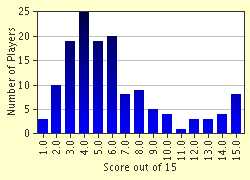Quiz Answer Key and Fun Facts
1. Whether or not one loves his artwork, one must admit the extraordinary influence and originality that Henri Matisse brought to the art world. Where was this French artist, member of the first wave of the 20th century avant-garde assault on conservative aesthetic tradition, born?
2. After finishing secondary school, Henri went on to Paris. He studied there for a year in order to become a part of which profession?
3. The key formative event in Matisse's young life came when he was 20 years old and recovering from a severe bout with which illness?
4. His first opportunity at an art education came ironically with the very conservative Adolphe-William Bouguereau. In which art academy was he enrolled to study under Bouguereau in Paris?
5. Matisse was 'rescued' from the stiflingly conservative style of Bouguereau by another famous French painter of the late 19th century. Who was this French master that had his atelier set up at the École des Beaux-Arts?
6. In 1898, with his star rising, Matisse was married. What was the name of his fiancé and soon-to-be wife?
7. By the late 1890s, Matisse was becoming quite a significant figure among the French avant-garde painters. A sign of his emerging leadership skills was his receiving of an honorary nickname from his peers. What did the young, Parisian artists offer to Matisse as his new sobriquet?
8. Matisse had, of course, already felt the influence of the Impressionists by the early 1900s. However, a fresh new influence was seeping into his brush that would help him develop his revolutionary use of pure, bright colors that characterize his most original works. This influence would come from the 'Neo-Impressionist' artists involved in the technique commonly known as Pointillism. Matisse read the writings of and befriended which practitioner of the Pointillist style in 1904?
9. The most consequential year in Matisse's art career came in 1905. During that year, he and his colleagues André Derain and Maurice de Vlaminck, exhibited a number of paintings at the Salon d'Automne. The powerful use of colors in the paintings at this exhibit created such a stir that art critic Louis Vauxcelles was driven to deem the artists collectively as which of these?
10. In 1910, Matisse created one of his most significant works. Upon a blue background we see a circle of reddish-brown women, hands clasped in a ring of dance. What is the title of this piece?
11. During the entire decade of the 1910s Matisse fell under the varying influences of a number of sources. Visits to Moscow allowed him to observe the iconic art of the middle ages, while visits to the Islamic world, and especially Morocco, allowed for a creeping in of Arab influence in his works. In the late 1910s he also paid a series of visits to which aging Impressionist artist, whose works seriously affected the Matisse paintings of the 1920s?
12. True or false: Though Matisse is known to us as one of the great painters of the 20th century, he was unsuccessful in his attempts at working in the realm of sculpture.
13. In 1941, ill health forced Matisse to slow down his professional work. With which of these maladies did the already 70-year old Matisse suffer, requiring surgery?
14. At nearly 80-years old, Matisse, remaining remarkably active, undertook an entire architectural project. He designed and built a small chapel as a return favor for a woman who had helped him during his period of convalescence. In which town was this chapel built between 1948 and 1951?
15. In the final years of Matisse's life he gave up painting in favor of his 'Gouaches Découpées'. Of which objects did these works of arts consist?
Source: Author
thejazzkickazz
This quiz was reviewed by our editing team before going online.
Any errors found in FunTrivia content are routinely corrected through our feedback system.

